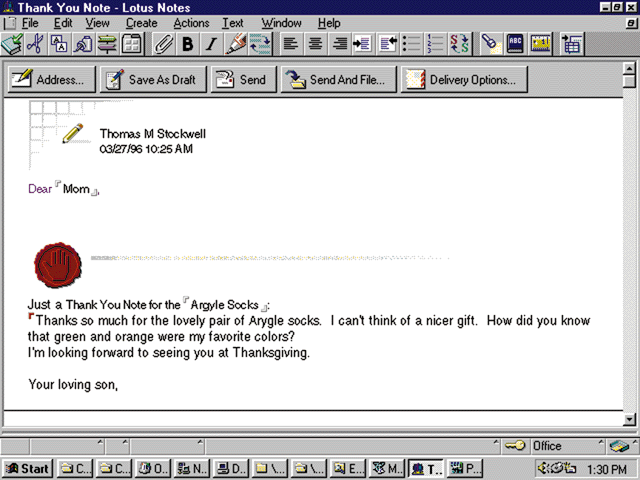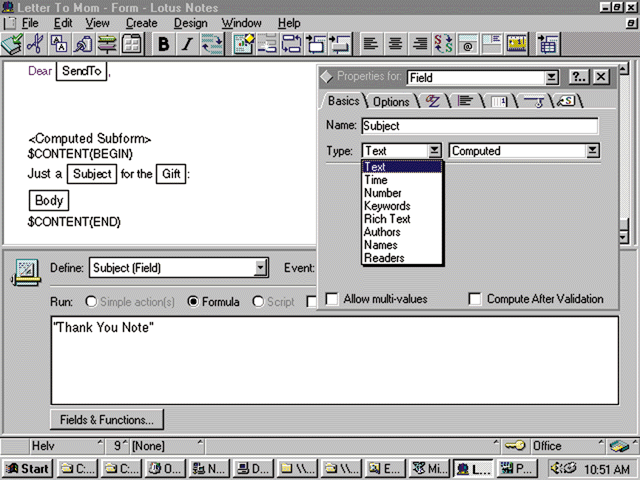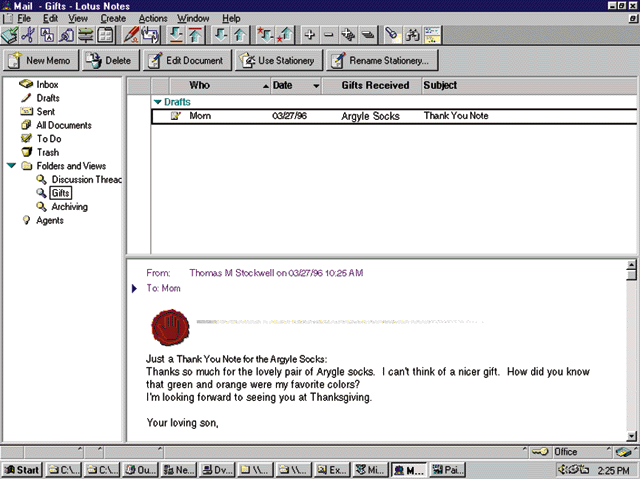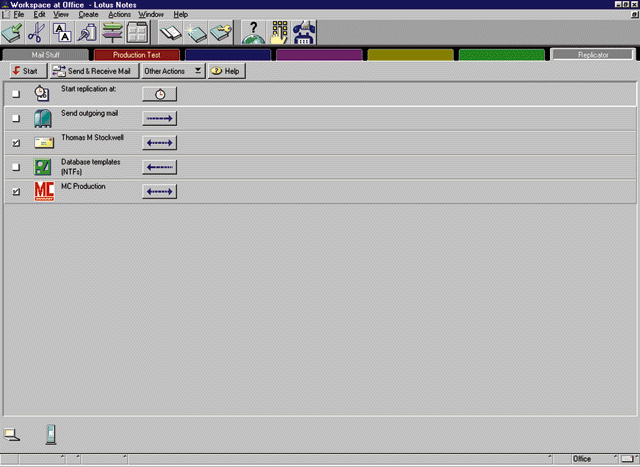On January 22, 1996, IBM and Lotus Development Corp. announced the first phase of a new office automation strategy. The announcement outlines how IBM's aging OfficeVision suite of calendaring and scheduling products will be integrated with Lotus Development's Notes Release 4.0. At the same time, IBM has released a statement of direction to make Lotus Notes run natively on the AS/400. All these press releases give us a tantalizing peek at the long-term strategy by which IBM may completely replace the OfficeVision suite with Lotus Notes.
But what exactly is Lotus Notes? There's a lot of confusion within MIS generally. Is it merely a PC LAN incarnation of the old OfficeVision product? Or is it, as some in IBM have intimated, the Holy Grail of the virtual office?
In this article, I'll give a little tour of Lotus Notes Release 4.0 to show you what it is, how it works, and how it will impact your users' lives. In the process, I'll investigate some new paradigms of databases and programming environments. What you'll uncover are some powerful new tools in Lotus Notes that might just release a new feeling of creativity in your staff. At the same time, you should be able to see exactly why IBM's fascination with Lotus isn't as simple as 1-2-3.
Lotus Notes describes itself as a "workflow automation tool." What is workflow automation? Isn't that just putting everything on computers? Not quite! Let's dig deeper!
In the virtual office, the fundamental denominator of communication is the "electronic document." An electronic document can be anything: an E-mail message, an expense report, a spreadsheet, a word processing document, or a simple memorandum. The workflow in the electronic office is the movement of these various electronic documents from one desktop to another through some form of E-mail.
Once these documents arrive at their destinations, however, something usually has to be done with them. All need to be read. Some need responses. Some need to be saved. Some need to be thrown out. If the volume of messages is great, the process gets overburdened. Sometimes, things get neglected, lost, or inadvertently misfiled.
Notes' workflow automation is a process by which electronic documents are automatically organized, routed, and communicated between desktops. The documents hold the intelligence to route and deliver themselves, to slip into appropriate databases, and to respond to their senders with preformatted, predestined responses. Lotus Notes provides integrated tools to build entire databases of documents that contain these embedded, intelligent, preprogrammed instructions. It also provides a means to program Agents for negotiating the workflow and transversing the virtual office. It includes an integrated E-mail system that can be interfaced to MS-mail, cc:Mail, or any E-mail that supports Simple Mail Transfer Protocol (SMTP). This includes, according to IBM, the AS/400's OfficeVision/400 product.
So how does Notes build intelligence into its database? Lotus Notes' database model differs completely from the relational model of the AS/400. It's based upon the concept of the document. To fully appreciate this difference, I'll walk through some of the design aspects of a typical Notes database. And to show how Notes can be useful, I'll design a simple E-mail response system that handles a typical and humorous problem plaguing most busy executives today: how to handle thank-you notes to Mom.
First of all, a Notes document is a data container that binds together various fields, formulas, and functions into a self-contained, atomic entity. A Notes document first builds upon an E-mail hierarchy of three different basic document types: It can be an original document, a response, or a response to a response. This hierarchy allows Notes to present a natural E-mail "discussion" thread, similar to discussion threads on a BBS. But that's only the beginning.
Inside the Document Database model, each document has a self-defined and unique structure that is controlled by the Form that created the document. Notes allows the programmer of the Form to internally define individual fields within a document. The fields may be numeric, text, time, keyword, Rich-Text, or one of several other special types. These fields exist only within the structure of the unique document and aren't externally described, as in DDS. (Fields can also sometimes be shared between documents, but that's a separate feature.)
I'll create a hypothetical document to show how this works. Let's imagine that you routinely take a piece of 8 1/2-by-11-inch typing paper to jot down thank-you notes to Mom for your birthday presents. Most of the note will usually be pure text, but you want to track two things: the day it was written and the actual gift itself (that fancy pair of argyle socks). And, since this note is just one of the many you'll send her during the year, you'll also want to categorize it specifically as a thank-you note. Later on, when you're feeling guilt-heat, you'll need this info to defend yourself. 1 shows how such a completed Notes thank-you document might appear to Mom.
I'll create a hypothetical document to show how this works. Let's imagine that you routinely take a piece of 8 1/2-by-11-inch typing paper to jot down thank-you notes to Mom for your birthday presents. Most of the note will usually be pure text, but you want to track two things: the day it was written and the actual gift itself (that fancy pair of argyle socks). And, since this note is just one of the many you'll send her during the year, you'll also want to categorize it specifically as a thank-you note. Later on, when you're feeling guilt-heat, you'll need this info to defend yourself. Figure 1 shows how such a completed Notes thank-you document might appear to Mom.
Notes created this document through a Form template. A Form is a structure that contains the unique elements and fields of the database. The Form that created this Dear Mom document is shown in 2. The programmer has developed a number of different fields, including the Subject field, which is highlighted. Notice that the Subject field, represented on the Form, has a formula defined; it's shown in the definition window below the layout. This formula provides an initial constant value of "Thank You Note" for the Subject field. Also, notice the Properties for this field (shown in the folder window) identify this as a computed text field. Other fields in the Form have their own unique values, embedded formulas, and associated functions. Finally, notice that the Form has two other fields: Gift and Body. The Gift field is the area in which you, the author of the note, will key in "argyle socks." This is a unique custom field of this particular Form. The Body field is the area in which you will key in the text of the message. The Body is usually a standard field in all Notes E-mail messages.
Notes created this document through a Form template. A Form is a structure that contains the unique elements and fields of the database. The Form that created this Dear Mom document is shown in Figure 2. The programmer has developed a number of different fields, including the Subject field, which is highlighted. Notice that the Subject field, represented on the Form, has a formula defined; it's shown in the definition window below the layout. This formula provides an initial constant value of "Thank You Note" for the Subject field. Also, notice the Properties for this field (shown in the folder window) identify this as a computed text field. Other fields in the Form have their own unique values, embedded formulas, and associated functions. Finally, notice that the Form has two other fields: Gift and Body. The Gift field is the area in which you, the author of the note, will key in "argyle socks." This is a unique custom field of this particular Form. The Body field is the area in which you will key in the text of the message. The Body is usually a standard field in all Notes E-mail messages.
All Notes documents can have this finely honed level of field control. As the user navigates through this document, the values of these fields can trigger embedded events that activate unique hidden formulas or functions within the document. For instance, you can create a View of the database that automatically selects this document for your use.
A Notes View is sometimes mistaken to be something akin to a DB2/400 (also known as DB2 for OS/400) logical file or a query: It is, after all, a means of identifying and selecting fields from a document database.
However, a Notes View is really more like a spreadsheet, and the process of designing a Notes View can be as unique as the process of creating a document Form. For instance, 3 shows a sample View designed to pull the entire document database into a columnar format and to display any documents that reference a field called Gift. This is the ultimate Birthday Gift Protection Database. If Mom calls you up next week to ask you if you've received your birthday gift (hint, hint, hint), you won't have to strain your overworked memory trying to remember the silly, useless things she sent you. Instead, you can quickly open the "Gift" view of your E-mail, look at your correspondence, and say, "But Mom, don't you remember? I sent you a note thanking you for those beautiful argyle socks."
However, a Notes View is really more like a spreadsheet, and the process of designing a Notes View can be as unique as the process of creating a document Form. For instance, Figure 3 shows a sample View designed to pull the entire document database into a columnar format and to display any documents that reference a field called Gift. This is the ultimate Birthday Gift Protection Database. If Mom calls you up next week to ask you if you've received your birthday gift (hint, hint, hint), you won't have to strain your overworked memory trying to remember the silly, useless things she sent you. Instead, you can quickly open the "Gift" view of your E-mail, look at your correspondence, and say, "But Mom, don't you remember? I sent you a note thanking you for those beautiful argyle socks."
"Oh," she'll invariably reply, "I forgot to check my E-mail."
This custom View will also automatically organize any responses that come back from Mom. You won't have to do a thing. As soon as your E-mail receives Mom's response, it will automatically be organized into the View. The View columns will expand showing the hierarchy of document types-original, response, or response to response-displaying the entire message workflow history.
Now, if you extend this rather simple example to a business environment, you might start to imagine the benefits of a Notes E-mail Document Database. By building and customizing document Forms and Views, your E-mail starts to do a lot of the manual work of tracking and organizing your workflow. Documents are sent out with unique categories and returned and sorted automatically into their appropriate locations. You can have Notes Mail automatically update multiple Notes databases for both you and your recipients. The tools to build these intelligent communications systems are all robustly developed in Lotus Notes.
In addition to Documents, Forms, and Views, Notes provides facilities to create individual Folders, Navigators, and Agents. A Notes Folder has much of the same functionality as a View-it organizes the fields of the document database into a columnar format-but has an added function: It physically separates the documents into like-groups. For instance, you can programmatically instruct Notes to organize all of your documents with the Subject field of "Thank You Notes" and selectively place them into their own separate Notes Folder. By programming the selection parameters of a folder, documents can automatically move to their predestined locations without manual manipulation by the user.
A Notes Navigator is like a menu module that allows the user to access the various Documents, Views, and Folders that have been created for the database. It too has internally described functions and formulas that are connected to visual graphical objects and icons.
Notes Agents are the only externally described functionality of the system. Agents in Notes are user-written macros that perform preprogrammed functions against the entire document database. The syntax for the Agents is written in a form of BASIC called Lotus Script. Lotus Script is a full object-oriented and compiled programming language, and its interface to Notes is through predefined object classes. The scope and power of Lotus Script is quite robust. For instance, it provides three object classes for ODBC: connect, query, and result-set. This obviously makes the capability to connect directly to DB2/400 on the AS/400 very straightforward.
Finally, Notes also provides a facility to automatically connect and organize communications across the World Wide Web. Using this facility, you can create and extend a global Notes E-mail archetype that transcends almost every electronic barrier.
Now, with so many finely tuned structural functions residing within the innards of each document database, you might wonder how a developer or administrator could possibly implement a Notes application? Where would you start? How would you handle change management? How can a database be maintained, modified, or distributed? The Notes approach is very different from what we in the AS/400 community might expect.
Lotus sells Notes with complete sets of prebuilt databases that are skeletal templates of fully functioning applications. Over 20 are included, and they're divided into five functioning groups:
o Discussion Workflows
o Approval Workflow
o Broadcast Workflow
o Reference Workflow
o Tracking Workflow
The process of creating a new database is simple: A Notes administrator selects a Workflow template that approximates some desired functionality. The administrator copies the template as a unique database. The programmer modifies, customizes, and tailors the new database's Forms, Views, Navigators, and Folders to fit the specific requirements of the project. Finally, a new production document database is generated from the modified template and then is published across the network.
When all the power and functionality of Notes is tallied, a Notes-based OfficeVision product on the AS/400 is a truly exciting prospect. And since Notes already functions under OS/2, it's a natural for the FSIOP and LAN Server/400 (see the sidebar, "Notes Cross-platform Specifications"). But will Notes take over from OfficeVision/400?
OfficeVision is a product with a long history, and many OfficeVision sites have preexisting applications with highly functional customized document management systems in place. So the real challenge for Notes and IBM will be the conversion and reengineering of these preexisting OfficeVision/400 applications. Consequently, the success of Notes on the AS/400 may have more to do with IBM's ability to migrate OfficeVision than with any inherent strengths of Notes itself.
For new workflow applications, Notes is already a proven winner. It's robust, scaleable, and highly functional. It works across multiple platforms and provides an excellent platform for highly sophisticated workflow automation systems. It's no wonder that IBM was so impressed with the product that it bought the company. IBM has chosen the right tool for the right job of bringing OfficeVision/400 into the realm of true client/server computing. You'll be hearing a lot more about Notes and the AS/400. We'll keep you informed as the workflow automation market heats up.
Thomas M. Stockwell is a senior technical editor for Midrange Computing. He can be reached by E-mail at
Inside Lotus Notes 4.0
Figure 1: Sample Document

Inside Lotus Notes 4.0
Figure 2: Sample Form

Inside Lotus Notes 4.0
Figure 3: Sample View

Inside Lotus Notes 4.0
Notes Cross-platform Specifications
To facilitate Workflow Automation, Notes uses a client/server model in which Notes documents are stored in one or more Notes databases on a server. Lotus supports the server portion of Notes software on AIX 4.1.3, HP-UX 10.01, OS/2 Warp, and Warp Connect, Sun Solaris SPARC 2.4, NetWare, and Windows NT 3.5.1. The addition of a native OS/400 server will round out the server offerings quite nicely.
A user accesses the database through the Notes Client or Notes Mail Client program on the user's desktop. Lotus provides Notes Mail clients for Windows 3.1, Windows 95, Windows NT, Macintosh, OS/2 Warp, AIX, HP-UX, and Sun Solaris. This makes a very robust cross-platform workflow and mail system.
From within the client, a user can access multiple custom-designed databases using the integrated Notes E-mail system. IBM already has a method of technically integrating this mail with OfficeVision/400. It's called AnyMail/400, and it's said that Rochester has had Notes running in the lab for some time using this facility.
The Notes Client software allows the user access to multiple databases that can exist on multiple servers running many different operating systems. Beyond that, though, a single Notes database itself can simultaneously exist on multiple clients and servers. This allows remote and mobile users of Notes to access and maintain their Notes databases even if they're not directly connected to the network.
To handle this distributed model, Notes provides an integrated replication service. Replication is a straightforward process: The user clicks on the Replication tab of a workspace folder and then chooses the databases that need to be reconciled. Notes makes the appropriate contacts to those databases through the network and then automatically handles the versioning of information (see A1).
To handle this distributed model, Notes provides an integrated replication service. Replication is a straightforward process: The user clicks on the Replication tab of a workspace folder and then chooses the databases that need to be reconciled. Notes makes the appropriate contacts to those databases through the network and then automatically handles the versioning of information (see Figure A1).
Inside Lotus Notes 4.0
Figure A1: Database Replication






















 More than ever, there is a demand for IT to deliver innovation. Your IBM i has been an essential part of your business operations for years. However, your organization may struggle to maintain the current system and implement new projects. The thousands of customers we've worked with and surveyed state that expectations regarding the digital footprint and vision of the company are not aligned with the current IT environment.
More than ever, there is a demand for IT to deliver innovation. Your IBM i has been an essential part of your business operations for years. However, your organization may struggle to maintain the current system and implement new projects. The thousands of customers we've worked with and surveyed state that expectations regarding the digital footprint and vision of the company are not aligned with the current IT environment. TRY the one package that solves all your document design and printing challenges on all your platforms. Produce bar code labels, electronic forms, ad hoc reports, and RFID tags – without programming! MarkMagic is the only document design and print solution that combines report writing, WYSIWYG label and forms design, and conditional printing in one integrated product. Make sure your data survives when catastrophe hits. Request your trial now! Request Now.
TRY the one package that solves all your document design and printing challenges on all your platforms. Produce bar code labels, electronic forms, ad hoc reports, and RFID tags – without programming! MarkMagic is the only document design and print solution that combines report writing, WYSIWYG label and forms design, and conditional printing in one integrated product. Make sure your data survives when catastrophe hits. Request your trial now! Request Now. Forms of ransomware has been around for over 30 years, and with more and more organizations suffering attacks each year, it continues to endure. What has made ransomware such a durable threat and what is the best way to combat it? In order to prevent ransomware, organizations must first understand how it works.
Forms of ransomware has been around for over 30 years, and with more and more organizations suffering attacks each year, it continues to endure. What has made ransomware such a durable threat and what is the best way to combat it? In order to prevent ransomware, organizations must first understand how it works. Disaster protection is vital to every business. Yet, it often consists of patched together procedures that are prone to error. From automatic backups to data encryption to media management, Robot automates the routine (yet often complex) tasks of iSeries backup and recovery, saving you time and money and making the process safer and more reliable. Automate your backups with the Robot Backup and Recovery Solution. Key features include:
Disaster protection is vital to every business. Yet, it often consists of patched together procedures that are prone to error. From automatic backups to data encryption to media management, Robot automates the routine (yet often complex) tasks of iSeries backup and recovery, saving you time and money and making the process safer and more reliable. Automate your backups with the Robot Backup and Recovery Solution. Key features include: Business users want new applications now. Market and regulatory pressures require faster application updates and delivery into production. Your IBM i developers may be approaching retirement, and you see no sure way to fill their positions with experienced developers. In addition, you may be caught between maintaining your existing applications and the uncertainty of moving to something new.
Business users want new applications now. Market and regulatory pressures require faster application updates and delivery into production. Your IBM i developers may be approaching retirement, and you see no sure way to fill their positions with experienced developers. In addition, you may be caught between maintaining your existing applications and the uncertainty of moving to something new. IT managers hoping to find new IBM i talent are discovering that the pool of experienced RPG programmers and operators or administrators with intimate knowledge of the operating system and the applications that run on it is small. This begs the question: How will you manage the platform that supports such a big part of your business? This guide offers strategies and software suggestions to help you plan IT staffing and resources and smooth the transition after your AS/400 talent retires. Read on to learn:
IT managers hoping to find new IBM i talent are discovering that the pool of experienced RPG programmers and operators or administrators with intimate knowledge of the operating system and the applications that run on it is small. This begs the question: How will you manage the platform that supports such a big part of your business? This guide offers strategies and software suggestions to help you plan IT staffing and resources and smooth the transition after your AS/400 talent retires. Read on to learn:
LATEST COMMENTS
MC Press Online